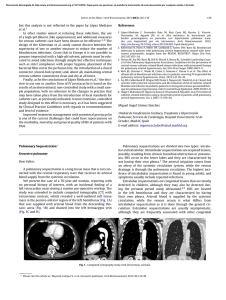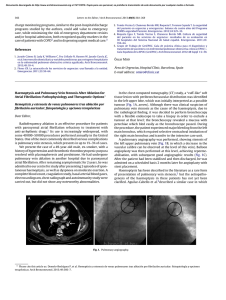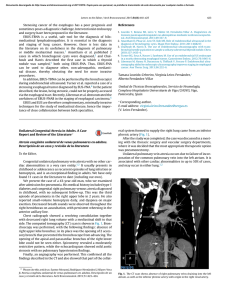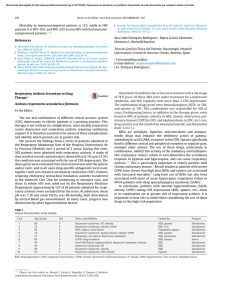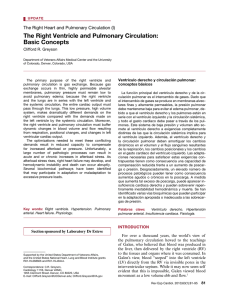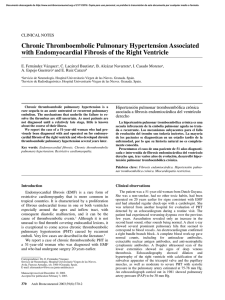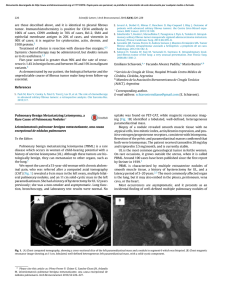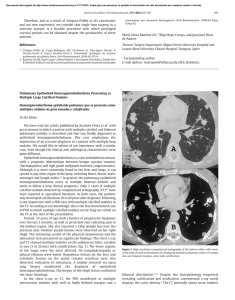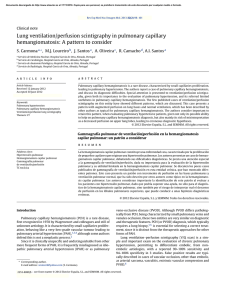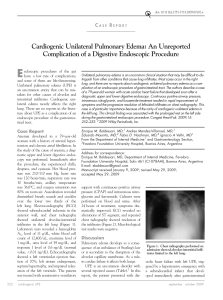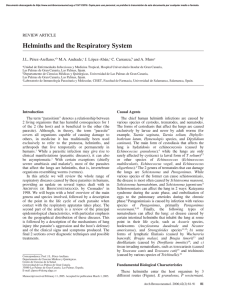Partial Anomalous Pulmonary Venous Connection With Pulmonary
Anuncio
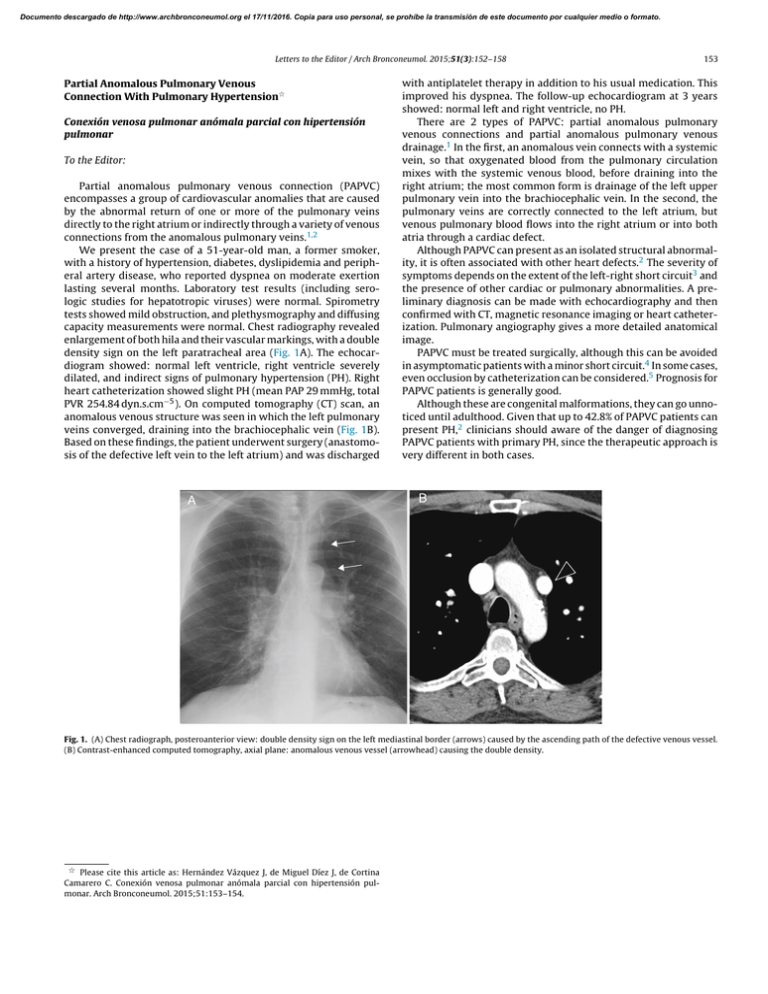
Documento descargado de http://www.archbronconeumol.org el 17/11/2016. Copia para uso personal, se prohíbe la transmisión de este documento por cualquier medio o formato. Letters to the Editor / Arch Bronconeumol. 2015;51(3):152–158 Partial Anomalous Pulmonary Venous Connection With Pulmonary Hypertension夽 Conexión venosa pulmonar anómala parcial con hipertensión pulmonar To the Editor: Partial anomalous pulmonary venous connection (PAPVC) encompasses a group of cardiovascular anomalies that are caused by the abnormal return of one or more of the pulmonary veins directly to the right atrium or indirectly through a variety of venous connections from the anomalous pulmonary veins.1,2 We present the case of a 51-year-old man, a former smoker, with a history of hypertension, diabetes, dyslipidemia and peripheral artery disease, who reported dyspnea on moderate exertion lasting several months. Laboratory test results (including serologic studies for hepatotropic viruses) were normal. Spirometry tests showed mild obstruction, and plethysmography and diffusing capacity measurements were normal. Chest radiography revealed enlargement of both hila and their vascular markings, with a double density sign on the left paratracheal area (Fig. 1A). The echocardiogram showed: normal left ventricle, right ventricle severely dilated, and indirect signs of pulmonary hypertension (PH). Right heart catheterization showed slight PH (mean PAP 29 mmHg, total PVR 254.84 dyn.s.cm−5 ). On computed tomography (CT) scan, an anomalous venous structure was seen in which the left pulmonary veins converged, draining into the brachiocephalic vein (Fig. 1B). Based on these findings, the patient underwent surgery (anastomosis of the defective left vein to the left atrium) and was discharged 153 with antiplatelet therapy in addition to his usual medication. This improved his dyspnea. The follow-up echocardiogram at 3 years showed: normal left and right ventricle, no PH. There are 2 types of PAPVC: partial anomalous pulmonary venous connections and partial anomalous pulmonary venous drainage.1 In the first, an anomalous vein connects with a systemic vein, so that oxygenated blood from the pulmonary circulation mixes with the systemic venous blood, before draining into the right atrium; the most common form is drainage of the left upper pulmonary vein into the brachiocephalic vein. In the second, the pulmonary veins are correctly connected to the left atrium, but venous pulmonary blood flows into the right atrium or into both atria through a cardiac defect. Although PAPVC can present as an isolated structural abnormality, it is often associated with other heart defects.2 The severity of symptoms depends on the extent of the left-right short circuit3 and the presence of other cardiac or pulmonary abnormalities. A preliminary diagnosis can be made with echocardiography and then confirmed with CT, magnetic resonance imaging or heart catheterization. Pulmonary angiography gives a more detailed anatomical image. PAPVC must be treated surgically, although this can be avoided in asymptomatic patients with a minor short circuit.4 In some cases, even occlusion by catheterization can be considered.5 Prognosis for PAPVC patients is generally good. Although these are congenital malformations, they can go unnoticed until adulthood. Given that up to 42.8% of PAPVC patients can present PH,2 clinicians should aware of the danger of diagnosing PAPVC patients with primary PH, since the therapeutic approach is very different in both cases. Fig. 1. (A) Chest radiograph, posteroanterior view: double density sign on the left mediastinal border (arrows) caused by the ascending path of the defective venous vessel. (B) Contrast-enhanced computed tomography, axial plane: anomalous venous vessel (arrowhead) causing the double density. 夽 Please cite this article as: Hernández Vázquez J, de Miguel Díez J, de Cortina Camarero C. Conexión venosa pulmonar anómala parcial con hipertensión pulmonar. Arch Bronconeumol. 2015;51:153–154. Documento descargado de http://www.archbronconeumol.org el 17/11/2016. Copia para uso personal, se prohíbe la transmisión de este documento por cualquier medio o formato. 154 Letters to the Editor / Arch Bronconeumol. 2015;51(3):152–158 References 1. Fulton DR, Soriano B. Partial anomalous pulmonary venous connection. In: Triedman JK, Kim MS, editors. UpToDate. 2013. Available from: http://www.uptodate.com [accessed 10.10.13]. 2. Sahay S, Krasuski RA, Tonelli AR. Partial anomalous pulmonary venous connection and pulmonary arterial hypertension. Respirology. 2012;17:957–63. 3. Brody H. Drainage of the pulmonary veins into the right side of the heart. Arch Pathol. 1942;33:221–40. 4. Ho VB, Bakalov VK, Cooley M, Van PL, Hood MN, Burklow TR, et al. Major vascular anomalies in Turner syndrome: prevalence and magnetic resonance angiographic features. Circulation. 2004;110:1694–700. 5. Clarke JC, Aragam JR, Bhatt DL, Brown JD, Ferrazzani S, Pietro DA, et al. An unusual cause of dyspnea diagnosed late in life: severe pulmonary hypertension resulting from isolated anomalous pulmonary venous connection. Circ Cardiovasc Imaging. 2013;6:349–51. Chronic Obstructive Pulmonary Disease Exacerbation by Corynebacterium propinquum夽 Exacerbación de la enfermedad pulmonar obstructiva crónica por Corynebacterium propinquum To the Editor: Corynebacterium propinquum (C. propinquum) is a bacterium found in the normal flora of the skin and mucous membranes that mainly colonizes the oropharyngeal region of the upper respiratory tract.1 Some rare cases of opportunistic respiratory infection by C. propinquum, often associated with immunosuppression or underlying lung disease, have been reported.2,3 We report a case of respiratory infection in a 75-yearold man, former smoker of 60 pack-years, diagnosed with chronic obstructive pulmonary disease (COPD) GOLD IV, treated with bronchodilators and high-dose inhaled corticosteroids, with a history of frequent exacerbations requiring antibiotics and systemic corticosteroids. The patient was hospitalized with a 1-week history of fever, increased dyspnea, and cough with purulent expectoration. Empirical treatment with levofloxacin began in the emergency room and samples were collected for microbiological analysis, including sputum for standard culture and urine for pneumococcal and Legionella spp. antigen testing, in view of initially suspected pneumonia. Rhonchi and wheezing were heard in both lung fields on physical examination. Clinical laboratory testing showed 17,040 leukocytes/mm3 (92% neutrophils) and blood biochemistry results were normal. Lung function tests revealed FVC: 1.6 l (52%), FEV1 : 0.63 l (27%) and FEV1 /FVC 39%. No infiltrates were seen on chest X-ray. The sputum Gram stain showed fewer than 10 epithelial cells and more than 25 polymorphonuclear leukocytes/100× field, and Gram positive bacilli with morphology suggestive of Corynebacterium spp. (10/1000× field). Culture was negative at 24 h, so it was reincubated. At 48 h, there was abundant growth of creamy, round, whitish, catalase-positive colonies. C. propinquum was identified using the API® Coryne system (bioMérieux), and subsequently confirmed by mass spectrometry (MALDI-TOF) and 16S rRNA gene sequencing. The disk diffusion method was used for antibiotic sensitivity testing, showing the isolate to be sensitive Julio Hernández Vázquez,a,∗ Javier de Miguel Díez,b Cristina de Cortina Camareroc a Servicio de Neumología, Hospital Infanta Leonor, Madrid, Spain Servicio de Neumología, Hospital General Universitario Gregorio Marañón, Instituto de Investigación Sanitaria Gregorio Marañón (IiSGM), Universidad Complutense de Madrid, Madrid, Spain c Servicio de Cardiología, Hospital Infanta Leonor, Madrid, Spain b ∗ Corresponding author. E-mail address: julio.hernandez@salud.madrid.org (J. Hernández Vázquez). to penicillin, ampicillin, ciprofloxacin, tetracycline, cefotaxime, vancomycin and rifampicin, and resistant to erythromycin and clindamycin. One of the main problems in establishing the etiological diagnosis of respiratory infections is the fact that the microorganisms that cause most respiratory infections often occur in the upper airways as part of the normal flora or as colonizers. Thus, to determine the clinical significance of these microorganisms, the quality of the respiratory specimen must first be evaluated by Gram stain. In this evaluation, generally performed in sputum, epithelial cells, suggestive of oropharyngeal contamination, and polymorphonuclear leukocytes, indicative of a pulmonary focus, are quantified. In our case, the Gram stain report suggested that the specimen was representative of a lower respiratory tract sample, so the cause of the exacerbation, in the absence of other causes, could be attributed to C. propinquum infection. The patient progressed well with clinical respiratory improvement, confirmed with a subsequent negative culture. Since C. propinquum was first described in 1993, very few clinically significant cases have been published. Most authors report it as an opportunistic pathogen and an emerging infection in both the respiratory tract and other sites.4 As mentioned, C. propinquum respiratory infection is rare, and has been documented mainly in hospitalized, immunosuppressed patients, and in patients with underlying respiratory disease, such as COPD or bronchiectasis, receiving wide-spectrum antibiotics.5 The few cases reported in the literature agree on the importance of the Gram stain for establishing the pathogenic role of C. propinquum, particularly in immunosuppressed or hospitalized patients who have received previous antibiotic treatment.2,3,5 Although C. propinquum is generally sensitive to vancomycin, multiresistant strains do exist,6 so antibiotic sensitivity testing is recommended for prescribing the appropriate treatment. In our opinion, although few cases have been published, C. propinquum can behave as an emerging pathogen. It can be responsible for COPD exacerbations, particularly if the patient presents predisposing factors, and the strain is isolated from a lower respiratory tract sputum sample. Conflict of Interest 夽 Please cite this article as: Prats-Sánchez I, Soler-Sempere MJ, Sánchez-Hellín V. Exacerbación de la enfermedad pulmonar obstructiva crónica por Corynebacterium propinquum. Arch Bronconeumol. 2015;51:154–155. The authors declare that they do not have any conflict of interest.
